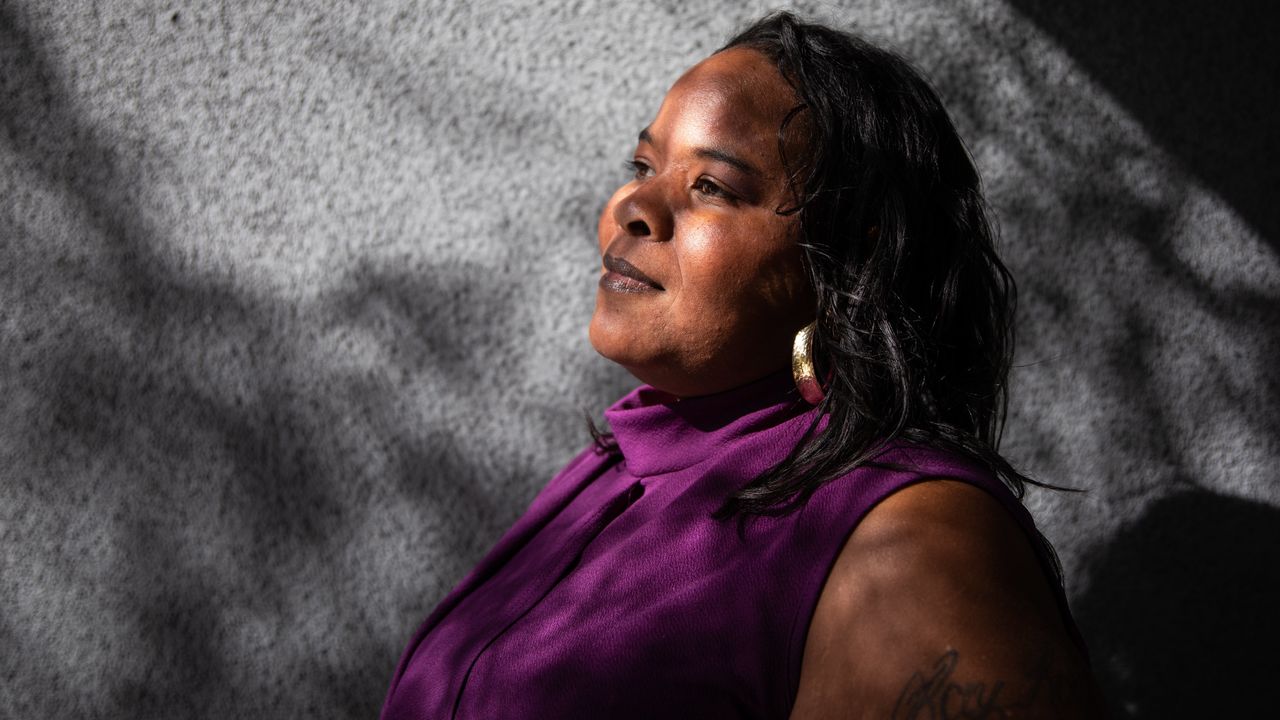On the morning of April 18, 2013, in the Los Angeles suburb of Buena Park, a throng of photographers positioned themselves on a street curb and watched as two police officers entered a squat townhouse. Minutes later, their cameras began clicking. The officers had re-emerged with a weary-looking woman in pajamas and handcuffs, and the photographers were jostling to capture her every step.
“You would swear I had killed somebody,” the woman, Cheree Peoples, said in a recent interview.
In fact, Peoples had been arrested for her daughter’s spotty school attendance record under a truancy law that then-California Attorney General Kamala Harris had personally championed in the state legislature. The law, enacted in January 2011, made it a criminal misdemeanor for parents to allow kids in kindergarten through eighth grade to miss more than 10 percent of school days without a valid excuse. Peoples’ 11-year-old daughter, Shayla, had missed 20 days so far that school year.
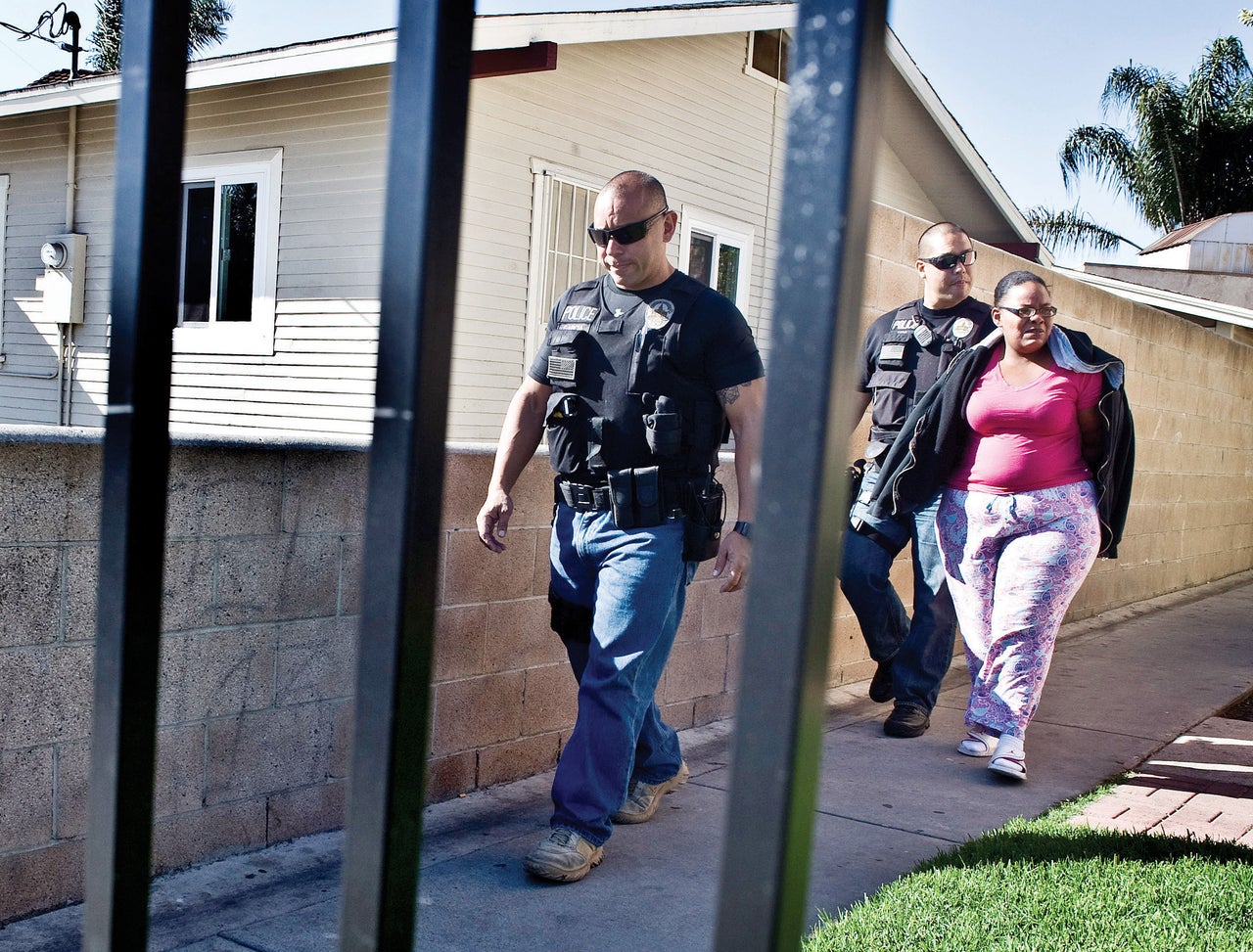
ABOVE: Buena Park police officers Luis Garcia (left) and James Woo escort Peoples, 33, to their patrol car on April 18, 2013. She was handcuffed and under arrest.
The law was the capstone of Harris’ yearslong campaign to get “tough” on truancy, the term for when a child consistently misses school without a valid excuse. Harris’ involvement began in the mid-2000s, when the future senator and 2020 presidential candidate was the San Francisco district attorney. Harris had been disturbed to learn that a disproportionate number of the city’s homicide victims were high school dropouts, and that dropouts are more likely to become perpetrators or victims of crimes. Preventing truancy, she argued, was not just about the noble goal of ensuring every child’s education, but a matter of averting future criminals. So it only made sense for the city’s top law enforcement officer to get involved. Harris filed charges against a handful of San Francisco parents whose elementary school-aged children were consistently missing school.
A few years later, she persuaded the state legislature to adopt harsher penalties for truancy. Under the new law, the parent or guardian of a young, truant child could face a fine of $2,500 or more — or one year in jail. Harris pushed hard for the law as she was running for attorney general, and it passed just as she won the election.
“We are putting parents on notice,” Harris said at her 2011 inauguration. “If you fail in your responsibility to your kids, we are going to work to make sure you face the full force and consequences of the law.”
Orange County heeded her call with particular enthusiasm. On the morning Peoples was arrested, police arrested five other parents — including several in front of waiting news crews — as part of what one assistant district attorney painted as an effort to prevent children from “being criminals or joining a gang.” The district attorney described Peoples’ conduct in unsparing terms, telling local news outlets she had ignored the school’s numerous requests for meetings and multiple warnings that Shayla was truant.
“The defendant was offered counseling and parenting classes,” read a press release from the district attorney’s office. “The student was provided the opportunity for a mentor through Big Brothers Big Sisters of Orange County, a mentor at school [and] monthly meetings with law enforcement officers.” Peoples never responded to those offers, it claimed.
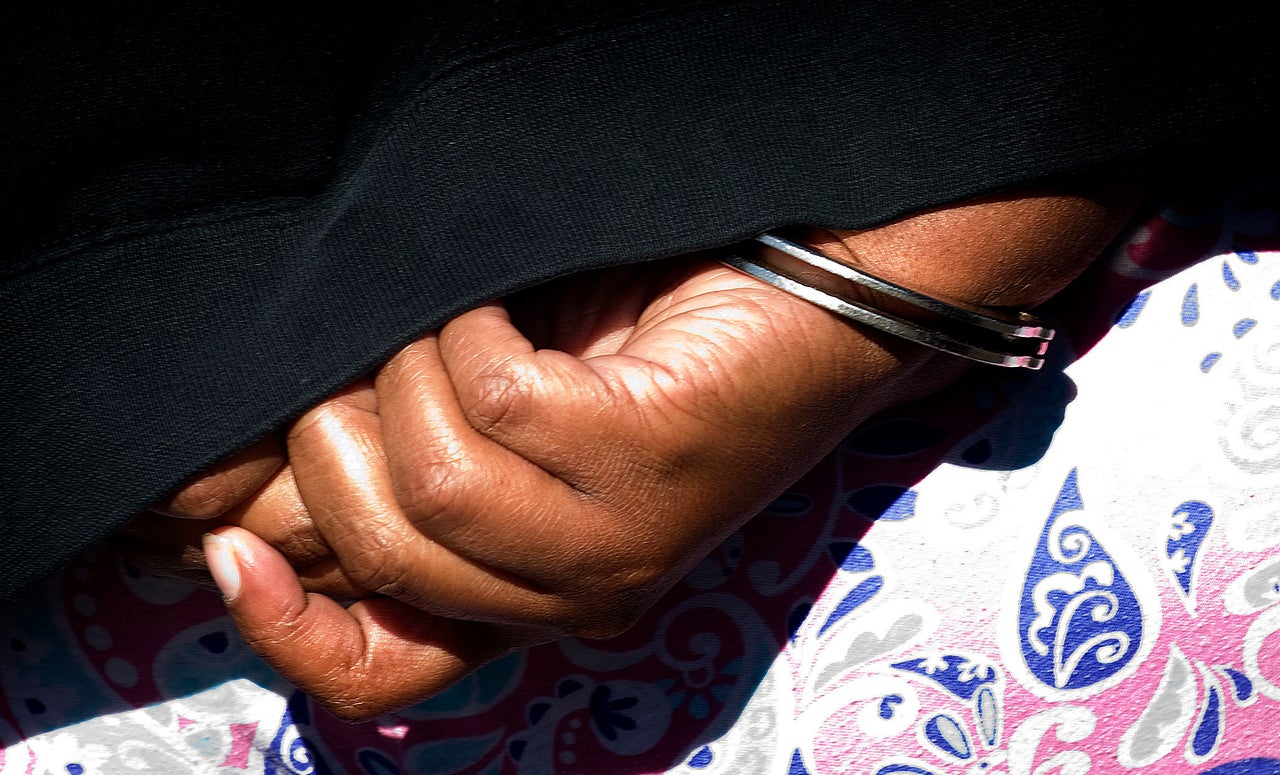
Peoples read all this several days later in a state of disbelief. She has a soft manner and voice and has dedicated most of her adult life to caring for Shayla — who has lived with sickle cell anemia, a serious genetic illness that causes her acute pain and requires frequent hospitalization and medical procedures, since birth.
Shayla frequently missed school because she was in too much pain to leave the house or was hospitalized for long-term care. Her school was aware of these circumstances; it had records on file from the regional children’s hospital explaining that Shayla’s condition would necessitate unpredictable absences and special educational accommodations. Peoples and the school had worked together to set up some of those accommodations, which are required under federal disability law. At the time of her arrest, Peoples claims she was fighting with the school to get it to agree to additional accommodations under an Individualized Education Plan, which she said the school had rejected.
“This is a young woman who spends a lot of her life in the hospital,” Peoples said. “How is it that she’s giving off the impression of being a gang member? … Why are they coming after me?”
Peoples was caught up in the hugely complex forces Harris and her tough-on-truancy stance unleashed more than a decade ago.
Harris has since replaced her punitive stance with the message that parents of truant children need help, not scare tactics. It’s a shift that happened roughly in step with voters’ waning tolerance for using the criminal justice system to address complicated social problems and Harris’ own preparations to seek higher office. In the memoir she released shortly before announcing her candidacy for president, Harris described her work on truancy as “trying to support parents, not punish them.”
Her evolution also supports the story she’s telling voters on the 2020 campaign trail: that she was trying to change the system from within in a way that is “consistent with progressive values.” She has packaged herself as part of a new generation of “progressive prosecutors” who used the office to achieve transformational change.
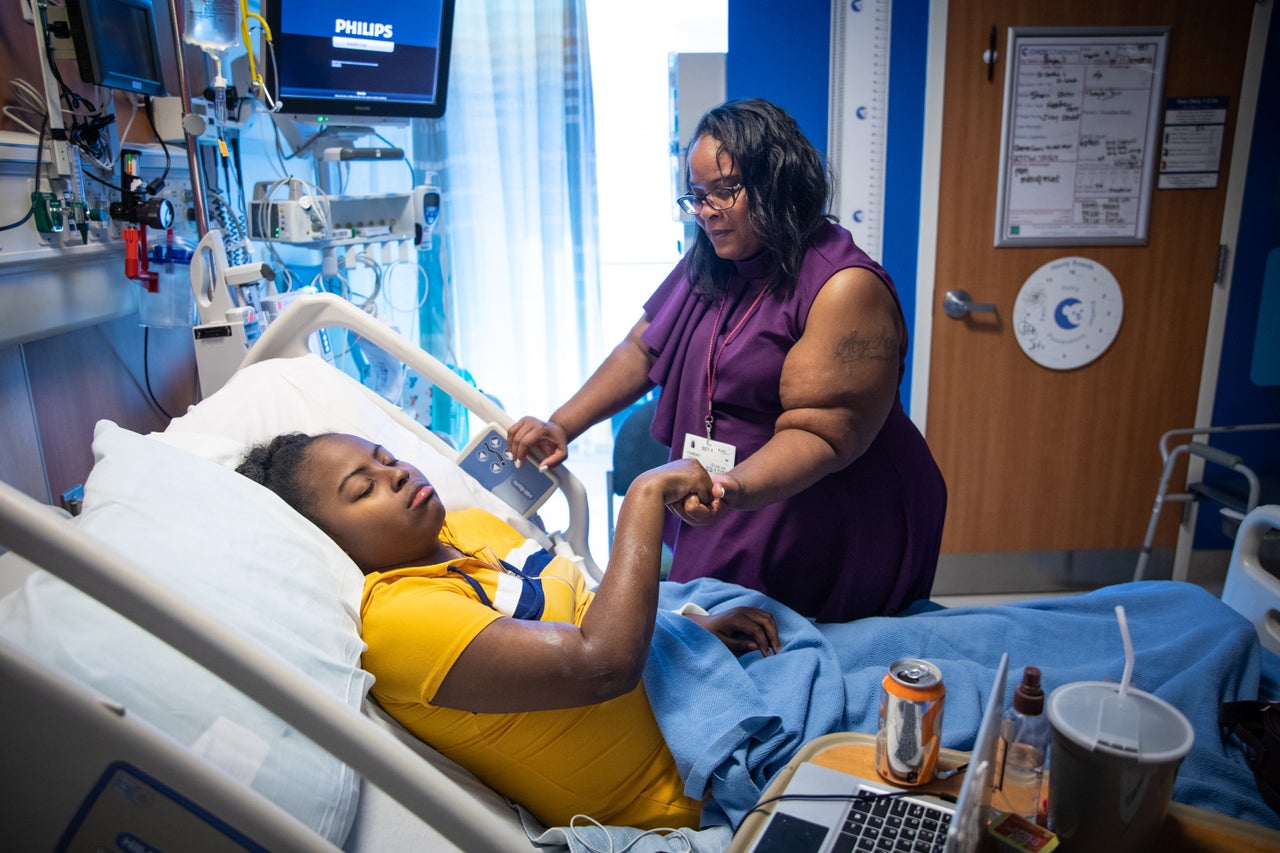
Yet the penalties she once championed for truancy and the way she originally thought about the issue are foundational to how California handles truancy today. Peoples’ arrest wasn’t a freak occurrence ― it was the inevitable outcome of Harris’ campaign to fuse the problem of truancy with the apparatus of law enforcement. And Peoples is far from an outlier. There are still hundreds of families across California entering the criminal justice system under the aegis of Harris’ law.
“I think it was a good thing that she shined a light on [truancy],” Jeff Adachi, who served as San Francisco’s chief public defender from January 2003 until his death on Feb. 22, told HuffPost in February. “There is a correlation between children who fail at school and what happens later in life. [But] the idea of locking parents up, or citing them with a crime because they’re not taking their children to school — it doesn’t address the root of the problem.”
Adachi said Harris’ record on truancy exemplified why he was always skeptical of the notion of a progressive prosecutor.
“That’s the common narrative, that you have a person who comes in and says, ‘I can change the system by becoming the system,’” he said in a January interview with public radio station KQED. “You can have some influence. But it’s a system because the people in power act according to the design. And if you’re a prosecutor, your job is to charge people with crimes.”
‘A Time Bomb’
Harris is hardly the first person to argue truancy should carry the possibility of jail time. Virtually every state has compulsory attendance laws and a long history of incarcerating parents — and even children — who fail to comply. A single county in Pennsylvania jailed more than 1,600 parents between 2000 and 2015 for their failure to pay truancy-related fines.
California law has made it possible to prosecute parents of truant children since at least 1977. That year, the state defined a truant as a student who was more than 30 minutes late to school three times, or who had missed three days of school, without a valid excuse; a truant’s parents could be fined $100 on their first conviction. Truancy wasn’t technically a jailable offense at the time, but prosecutors who wanted to see jail time often charged parents with the crime of “contributing to the delinquency of a minor.”
Despite being the focus of so much enforcement, the question of what causes children to miss school wasn’t the subject of much scholarship until about 10 years ago.
Hedy Chang, the executive director of Attendance Works, a nonprofit that studies and promotes best practices for reducing school absence, walked me through some of the emerging research, much of which is no surprise: Regular school attendance is vital to almost every aspect of a child’s future. Young children who miss too much school are less likely to develop basic social and academic skills as a consequence, and they are more likely to fall behind in class and drop out of school as they grow older. The tipping point for when the risk sets in is around 10 percent of missed instructional time. And the negative effects of missing school are more pronounced for children in lower-income families.
Researchers have identified some common reasons for school absences including barriers outside the school, such as a chronic illness, a lack of housing or not having a safe path to school; a negative school experience, such as a harsh or biased learning atmosphere; a lack of engagement because of something like high teacher turnover; or a lack of understanding, on the part of parents, of the risks of missing too much school.
Other new research has called the law-and-order approach into question. The evidence increasingly shows that pure punishment is less effective than prevention. Schools can prevent many instances of truancy by making parents aware of the associated academic risks and by identifying and fixing the systemic barriers to attendance, such as bullying, unreliable transit or safety issues.
There has been less research into the best methods of intervention, although it generally supports positive, personalized outreach. And there has been very little research into the appropriate role of law enforcement. According to what does exist, law enforcement is only effective when combined with earnest prevention efforts and outreach.
“A punitive legal approach, I just haven’t seen evidence that shows that works,” Chang said.
New research also suggests that “truancy” is an arbitrary metric. The term refers to unexcused absences, but California gives individual schools substantial flexibility to determine what constitutes a valid excuse. (Certain reasons, like illnesses and religious observances, are always valid by law.) As a measure of academic risk, it makes more sense for schools to track absences, since ultimately what matters is the amount of school a child misses and not the reason why.
“Truancy” is more like a measure of blame, and blame is subject to all sorts of biases. It’s not clear if students of color are more likely to have their absences deemed “unexcused” than white students who miss school for the same reasons. But we do know that black and Native American students, nationally, make up a disproportionate share of truant students.
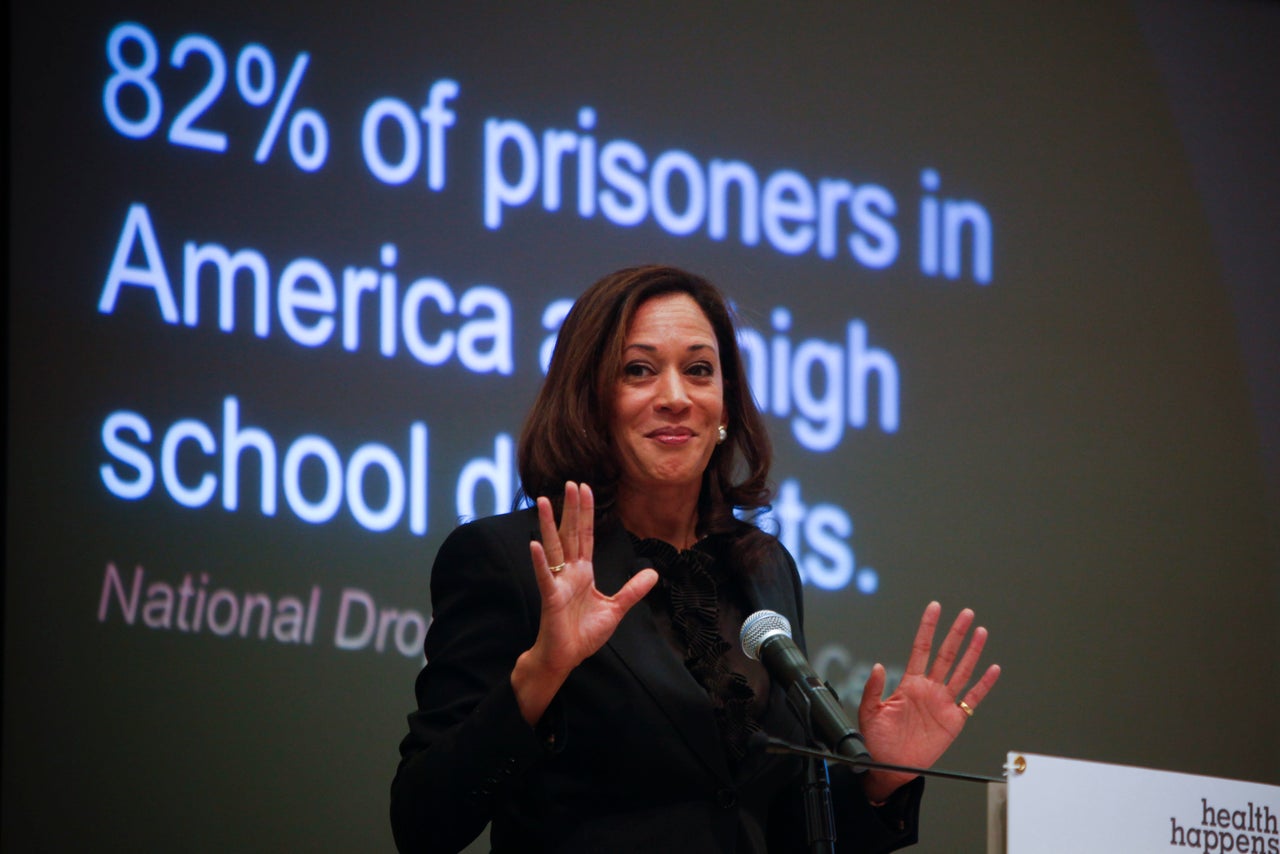
What jumped out to Harris was the connection between truancy in early childhood and devastating outcomes later in life. “Ignoring truant children is like tiptoeing over the sizzling fuse on a time bomb,” she wrote in her first book, Smart On Crime, in 2009.
As district attorney, she had her office send letters to every household with a child in public school explaining that truancy was a crime — and one she was prepared to prosecute. Most schools already had a policy of calling or meeting with parents whose children missed too much class, and school officials began referencing her threats in their phone calls. Harris assigned county prosecutors to attend those meetings and “look as stern as they could,” she wrote.
Community activists at the time found Harris’ threats shocking and “crude.” They predicted the hammer would come down hardest on the most vulnerable families and make their circumstances worse.
But Harris admirers said her focus on truancy exemplified her itch to transcend the traditional role of a prosecutor.
“The thing about Kamala that I saw on every issue I worked with her on, she is always asking, ‘What are the root causes of the problem?‘” said Jill Habig, who oversaw juvenile justice issues for Harris’ office after she was elected attorney general. “She really rejected the notion that all a prosecutor should do is focus on charging people with crimes and putting people in jail.”
Harris wasn’t perturbed by the criticisms, either. She charged six parents with infractions in 2008, using a newly created truancy court that had special procedures. The judge deferred any punishments as long as families began to comply with the law. “The goal was not to get them into trouble but to find a way to exert enough pressure on them that they would change,” said David Kopperud, the longtime chair of California’s statewide student attendance review board.
“What it ended up being, practically, is families and kids having to come to court to be told to utilize certain services in order to come to school. Which, from where I sit, is very much the job of the school district and not the job of the criminal court.”
- a public defender
San Francisco’s truancy rate began to fall. In a speech she gave a few years later, Harris credited her tough approach, saying, “We threatened the parents of truants with prosecution, and truancy dropped 32 percent.”
What distinguished Harris’ approach wasn’t the process itself as much as who was involved, and when. She was using the same basic system — the school identifies a truant student; the school contacts the parents; the school, or a local attendance board, holds a meeting, if necessary; the school refers the problem to the district attorney, if necessary — that counties across California had been following for decades. Harris’ innovation was that school authorities and the district attorney would work in concert, articulating the threat of prosecution much earlier in the process and keeping school officials involved long after a case was transferred to court.
“It was using the law to support what the school was doing, and vice versa,” Kopperud said. “And she had a lot of success.”
Limitations
Harris was elected California attorney general in 2010, and she wasted no time in taking her model statewide. Her office began to spotlight the counties with the most dismal truancy rates and how many tens of thousands of dollars it cost them. (A school’s average daily attendance is part of the state’s education funding formula, so schools lose money when students are frequently absent.) She highlighted best practices and issued sweeping recommendations for raising attendance with language that was notably softer than what she used in public.
“Early intervention by law enforcement should be supportive, not punitive,” the first report read. She added muscle to local attendance review boards — in the truancy process, they sit above the individual school but below the county court — by requiring them to include a representative of the district attorney’s office, and, after a brief outcry, of the public defender.
But it was her first victory that attracted the most notice and outrage: In 2011, at Harris’ urging, California enacted its first-ever criminal penalties for parents of truant children. Previously, having a truant child was an infraction punishable by a small fine. Under the new law, parents of truant children could be charged with a criminal misdemeanor and face a fine of at least $2,000, or up to one year in jail. The law defined a child to be truant if he or she missed 10 percent or more of school days without a valid excuse and the school district has attempted a certain number of interventions. Just as in her San Francisco trial run, the law allowed the court to defer judgment if the parent agreed to a mediation period and turned things around.
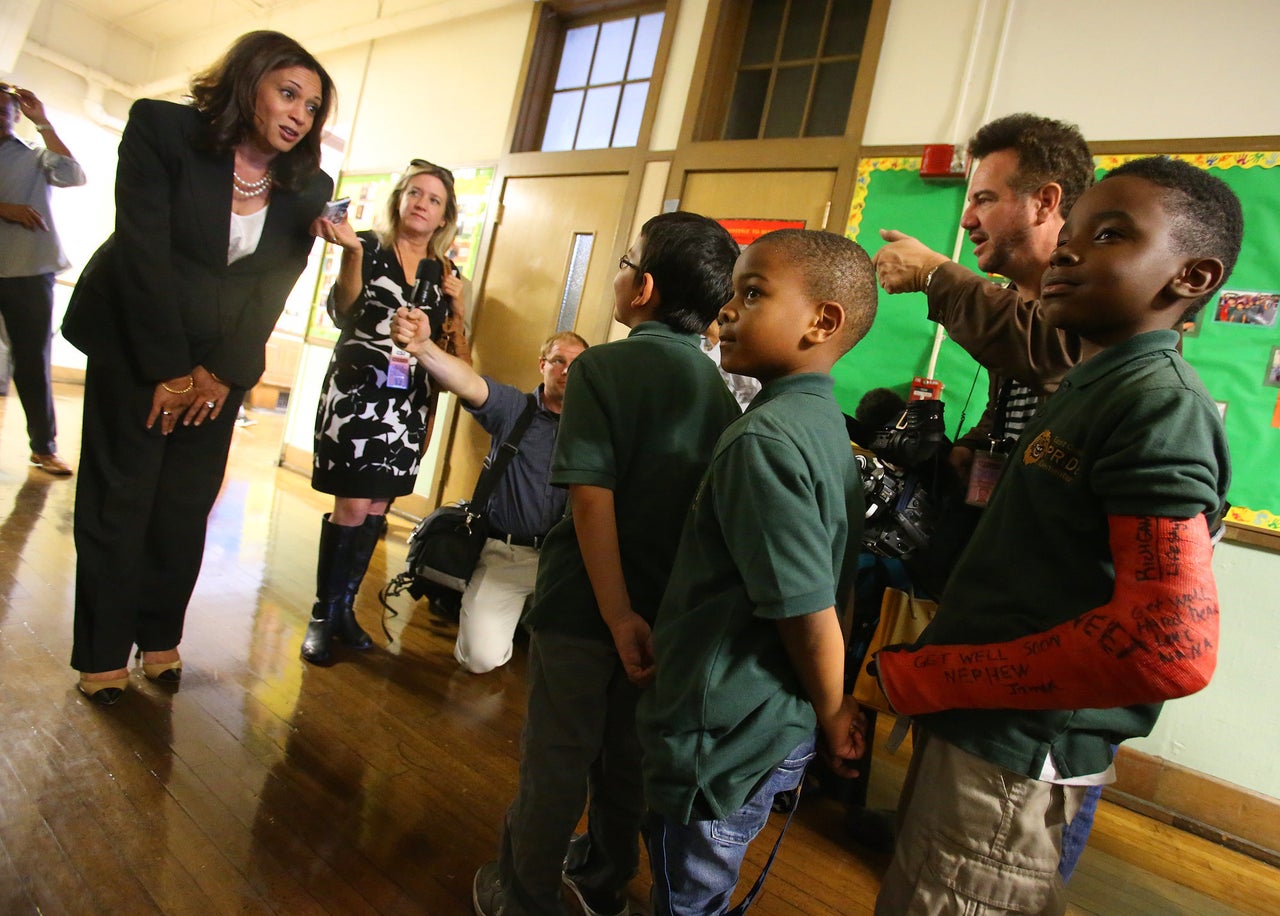
By now, many felt the San Francisco model had clear limitations. Parents were not being jailed or fined en masse as activists had initially feared. But to critics, the language Harris used to encourage a truancy crackdown and the system she reinvigorated were cementing the idea that parents always were the ultimate source of the problem.
Most of the families in truancy court were dealing with circumstances largely or entirely out of their control, said a public defender who represented parents in San Francisco’s truancy court for many years. That often included violence at school or a school’s failure to accommodate a chronic illness. If a family wasn’t responding to the school, it was usually because they were dealing with bigger crises having to do with poverty. Almost all of the parents under the microscope were black or Latino.
“What it ended up being, practically, is families and kids having to come to court to be told to utilize certain services in order to come to school,” said a public defender who asked not to be named because she continues to work in juvenile justice. “Which, from where I sit, is very much the job of the school district and not the job of the criminal court.”
The system was not set up to correct the more powerful forces arrayed against the parents. “Their idea was, you’re not going to school, and — whether or not what the school district is doing is sufficient to get you to school — we have this mechanism to cite you,” the public defender said.
I put some of these criticisms to Katy Miller, a prosecutor in the San Francisco District Attorney’s office who has worked on truancy issues since Harris’ time.
“I ask myself those same questions, and I think [Harris] did as well: At the end of the day, what is the solution in these cases where we feel like everything has been offered and the dynamic hasn’t changed?” she said. “Are we just going to let it be? It’s a hard question, I think we should be very parsimonious as prosecutors.” In San Francisco, Miller said, the district attorney only takes parents to court if their kids have missed 40, 60 or even 80 days of school.
Habig defended Harris, noting that as attorney general, Harris formed a new agency called the Bureau of Children’s Justice to investigate and solve systemic barriers to education; the idea was to hold the education system accountable, not just parents.
As attorney general, however, Harris had limited influence over whether local prosecutors carried out the spirit of her new law. Several counties that had always taken a punitive approach simply reserved the new penalties for the parents they saw as the worst of the worst. Each year, Kings County, in the Central Valley, charges hundreds of parents with infractions under California’s old laws; it has charged 19 misdemeanors under Harris’ law in the past four years, and at least two mothers have been sentenced to jail. In Tulare County, also in the Central Valley, there have been 14 cases, and they bring officials there a sense of pride. In a brochure from a 2016 student attendance conference, the county lauded its attendance supervisor as having “successfully submitted” three truancy cases the district attorney charged under Harris’ new law, on top of 500 cases being charged under California’s old laws.
Orange County, where Peoples was arrested, has charged a total of 22 parents under Harris’ law. The district attorney’s office, Shayla’s elementary school, and the Buena Park School District all declined to answer questions about Peoples’ case or how prosecution decisions are made. Tony Rackauckus, who served as the district attorney at the time of Peoples’ arrest and left office this January, also declined to answer questions but said he was “extremely proud” of his offices’ anti-gang efforts, including truancy enforcement. (Almost all of the truancy prosecutions under Rackauckus occurred in the 18 months leading up to one of his re-election campaigns; it’s not clear if this is a coincidence.)
And San Francisco — Harris’ old district — hasn’t actually charged any parents under the new law. Prosecutors there haven’t found it necessary to be that punitive, Miller said.
The Bully Pulpit
Assessing Harris’ legacy is difficult. She wasn’t the only one pushing new policies around truancy, and crucially, she didn’t get everything she wanted. Then-Gov. Jerry Brown (D), citing a need to preserve local autonomy, blocked a measure that would have forced all 58 counties to follow the same basic truancy process and a bill to track the number of truancy prosecutions that occurred under Harris’ law. As a result, the state still doesn’t know how many parents have been arrested, arraigned or full-on prosecuted under Harris’ criminal truancy statute, Kopperud said.
In fact, for all its investment in addressing chronic absenteeism, California isn’t sure if class attendance has gone up or down over the past decade. The state can’t make a clean comparison because it has changed the way it collects data several times, Kopperud said.
But no one really doubts that Harris had a meaningful impact.
“She was able to use her office as a bully pulpit for the understanding that chronic absence and truancy were both major issues, to help people understand the scope and scale … and the value of taking a positive, problem-solving approach,” said Chang, the Attendance Works executive. That made a much bigger difference than adding new criminal penalties, she said.
What Harris says from that bully pulpit has changed over the years. When she was San Francisco’s district attorney, she talked about “getting tough on truancy” and called truancy “a parent issue” stemming from “neglect.” If her prosecutors happened to discover that the parents they were prosecuting faced difficult circumstances, she framed it as incidental to the larger problem of failed parenting.
“Along the way, we learned some things about the situations some of these families faced and found we could help,” she wrote in Smart On Crime. “For example, we met a mother with three children who was homeless and holding down two jobs trying to get her situation under control.” Harris’ office helped her find housing.
Ten years later, Harris would say that connecting parents to the appropriate resources was the whole point. (Her campaign declined an interview request.)
“[Critics] assume that my motivation was to lock up parents, when of course that was never the goal,” she wrote in her 2019 memoir, The Truths We Hold. “Our effort was designed to connect parents to resources that could help them get their kids back into school, where they belonged. We were trying to support parents, not punish them—and in the vast majority of cases, we succeeded.”
Her story had evolved enough that I was curious to see which version applies in California today. So in February I traveled to Humboldt County, in northern California, to observe a monthly session of the county’s student attendance court. Outside there was a historic downpour, but Judge Joyce Hinrich’s voice was upbeat as she told the damp crowd of parents and students that her court was about changing behavior, not punishment. She promised there wouldn’t be any fines or jail time as long as the student’s attendance improved.
The judge led the court in several rounds of applause for families whose attendance was getting better, but eventually it came time for new arraignments. A woman named Shannon, who was there with a pair of little boys in rain boots and large sweatshirts, spoke to me in the hall with a shaking voice after entering a not-guilty plea.
“I’m very disturbed to be here again,” she said, her voice trembling. Her sons are avoiding school because they are being viciously bullied — recently, she said, another boy kicked her younger son in the crotch so hard he couldn’t walk the next day — and this was her second misdemeanor charge in five months. She felt as though she was out of options.
Rory Kalin, the public defender representing several parents that day, has heard countless similar stories. Kalin feels about one-third of his clients haven’t done anything wrong; in the other two-thirds of cases, the parents have made missteps against the backdrop of a larger issue such as poverty, homelessness or trauma. Humboldt County covers 4,000 square miles of rugged forest and lacks reliable transportation. It is also home to many Native American families, for whom school often has a traumatic association — government-run education, historically, was a tool of forced assimilation.
Although Kalin supports the student attendance court and says everyone is working in good faith, “there are these overarching issues that this court can’t address,” he said. “To hold a parent responsible for that is fundamentally unfair.”
School officials are deeply sensitive to these broader problems. For every Humboldt County parent facing prosecution — there were 35 misdemeanors charged in the 2017-18 school year, the county said — there are scores who worked with the schools to reach a solution before things escalated. Gillian Wadsworth, a licensed clinical social worker with the county education department, tries to help every parent avoid court by connecting them to free or low-cost services such as transportation, counseling, medical care, substance abuse treatment or temporary shelter.
When law enforcement takes the wheel, it tends to be because the family — often for complicated and sympathetic reasons — isn’t responsive and the school finds itself in a bind. Shannon hasn’t reached out to Wadsworth, she noted, and her phone number is disconnected. “The law is pretty clear,” Wadsworth said. “When the law is broken … right now the system that exists and can intervene is the criminal court.”
And yet not everyone is subject to the same system. State-run classrooms for incarcerated youth have posted some of the highest truancy rates in California, often without consequence. The state’s private schools, which enroll an estimated 647,000 students, aren’t legally required to participate in this system, Habig confirmed, meaning parents who can afford private school are functionally exempt from truancy prosecutions.
Wadsworth understands these inequalities on a personal level. Her daughter, who is in high school, has a serious medical issue and at times has had to miss 20 percent of the school year. Wadsworth has never been in the kind of trouble that would land her in truancy court, in part because she knows “how to work the bureaucracy,” as she puts it. “My family has enough resources and connections and the skill base to make sure the school is happy with why it is that she’s absent and prevent any large-scale intervention in my life,” she said.
The families present in Hinrich’s court the day I visited have much more complicated lives. They hadn’t been arrested and perp-walked, and it’s unlikely any of them will wind up paying fines or serving jail time — Kalin, the public defender, could only recall one or two cases ending in formal punishment. But for many there will be a lasting sense of stigma, Kalin said.
For all his and Hinrich and Wadsworth’s efforts, there was no mistaking the place where they determined parents’ fates as anything other than a criminal court. An armed bailiff scolded people for having their phones out. “DO NOT COMMUNICATE WITH THE PRISONERS,” signs on the walls warned visitors.
As the last of the families trickled out, I exited to the hallway to find Martin Morris, an assistant district attorney.
“I hope you enjoyed what you saw today,” he said as he put on his winter coat. “It works for some and we’re happy with that.”
‘Living The Worst Nightmare’
Peoples’ case trudged through the judicial system for two years. She had dozens of court dates, at least one every month, and at times it seemed as if the entire district attorney’s office was involved. Her case was passed among eight different prosecutors, including a recent transfer from the homicide squad.
When she was with Shayla, she tried to mirror her daughter’s sunny outlook.
“She is a joy,” she said. “Shayla is one of those kids you wish every kid was like.”

In private, though, she was fraying. During her ordeal, Peoples kept an on-and-off video diary in which she appeared haggard and anxious. “It’s hard on the body, it’s hard on the mind,” she said softly in one entry. “Right now, I am living the worst nightmare that any mother could possibly understand and go through.”
But Peoples held fast to her not-guilty plea. She refused to agree to anything that didn’t amount to a total exoneration. She especially balked when the prosecution offered not to pursue the charges if she took parenting classes, thinking, what parenting classes could cure sickle cell? On Aug. 12, 2015, the charges were finally dismissed.
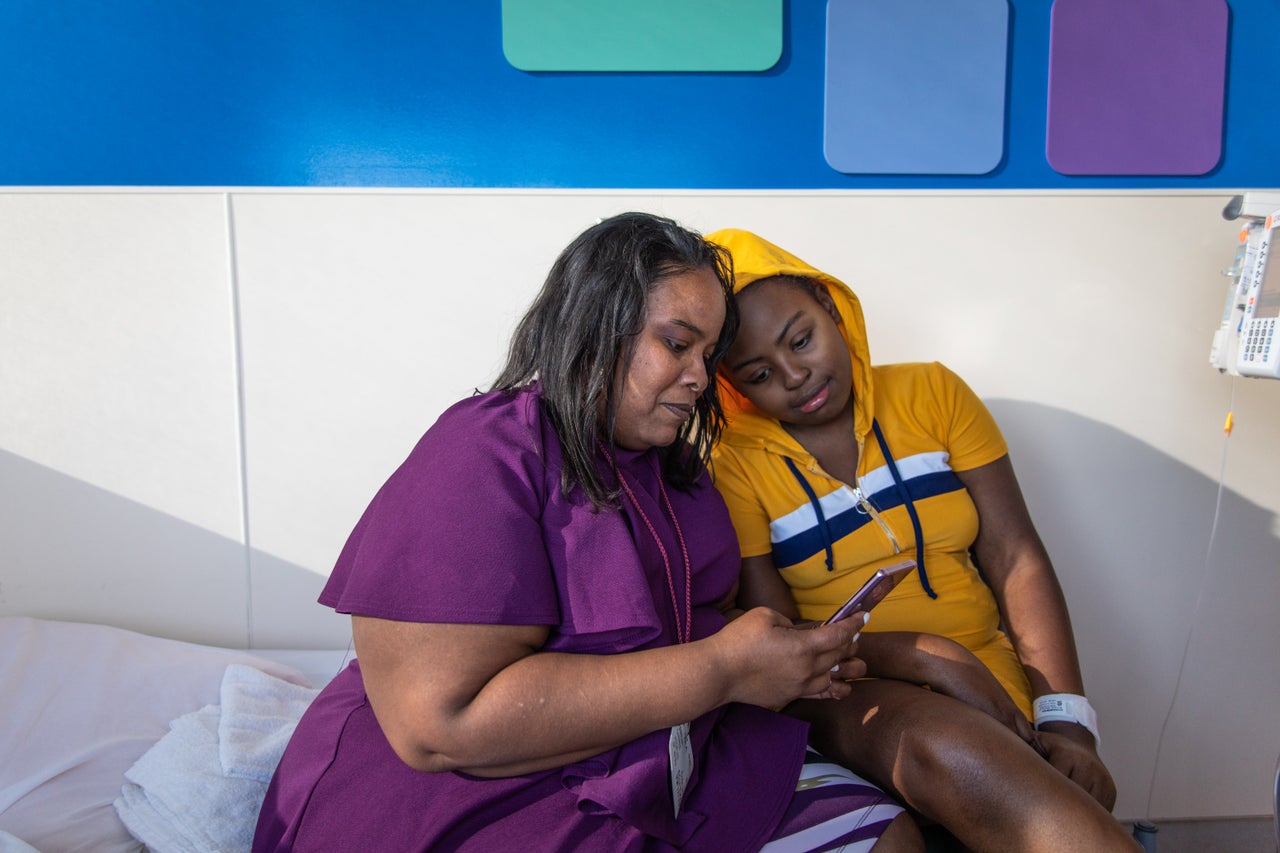
Peoples does, in fact, struggle with the kinds of issues that the truancy process can supposedly bring to light and resolve.
There is the all-encompassing fact of her daughter’s illness, which causes Shayla chronic pain and has required regular hospital stays, including multiple surgeries and countless blood transfusions. Peoples is also dealing with all of the consequences of dedicating herself so fully to her daughter’s care. She cannot realistically hold a full-time job. She has struggled to afford a place to live, faced eviction, and dealt with homelessness. On certain dates when the school alleges it was trying to meet with her, Peoples was recovering from the C-section birth of her son. In recent years, she has also become a part-time caretaker for her mother, who had a stroke.
Her recollection of how the school reacted to all of her challenges is very different than what the district attorney laid out. Instead of offering her help, Peoples said, the officials at Shayla’s elementary school tended to stonewall her or be suspicious. There were several times where it felt as though the school didn’t believe her when she said Shayla was not well enough to attend school, Peoples said. School officials were opaque when she asked if they needed more doctors’ notes, she claims. Peoples said she even asked for some of the resources that the district attorney would later claim she turned down — like a peer mentor for Shayla — and that the school wouldn’t communicate. The school began counting Shayla as absent without an excuse just a few days after they rejected one of Peoples’ requests for medical accommodations, Peoples said.
Today, Shayla is in high school. She’s been in the school choir and band. There are just as many days when she is in too much pain to go to school or can’t go because she is hospitalized. But Shayla’s new school works with Peoples to accommodate her needs, and as a result, Peoples’ legal troubles over truancy are behind her.
It wasn’t a victory as much as something Peoples survived. “I lost time with my son” and Shayla, she said. “I lost life. I lost me.”
Jessica Schulberg contributed reporting.
